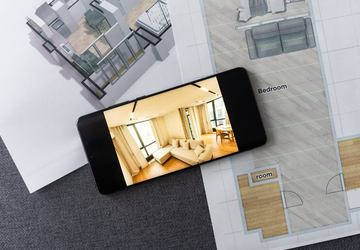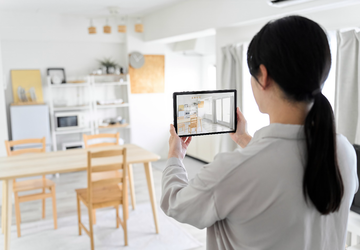How Can Augmented Reality (Ar) Improve the Home-Buying Experience
Augmented reality (AR) can significantly enhance the home-buying experience by providing 3D virtual tours and visualization, allowing potential buyers to explore properties remotely. With this technology, you can have a realistic and engaging experience, enabling you to visualize changes such as different furniture layouts, paint colors, or renovations, and helping you make more informed decisions.
Augmented reality (AR) can significantly enhance the home-buying experience by providing 3D virtual tours and visualization, allowing potential buyers to explore properties remotely. With this technology, you can have a realistic and engaging experience, enabling you to visualize changes such as different furniture layouts, paint colors, or renovations, and helping you make more informed decisions.
What is Augmented Reality?
Augmented reality is a technology that superimposes digital data, such as images, videos, or data, onto the real world in real-time. This enhancement is typically viewed through devices like smartphones, tablets, or AR glasses, which use cameras and sensors to map the physical environment and integrate digital elements seamlessly into it.
AR differs from virtual reality (VR), which creates a completely immersive virtual environment. Rather, augmented reality (AR) combines digital content with the physical world so that users can interact with both at once. This technology is used in various applications, from gaming and entertainment to education, retail, and professional fields like architecture and real estate, enhancing how users interact with their surroundings and receive information.
Buying a New House: Virtual Home Tours vs. Traditional Home Tours

Purchasing a home is a serious financial decision that calls for thorough planning, investigation, and frequently the help of experts like lenders and real estate brokers. Virtual home staging and traditional real home staging are two approaches to presenting a home to potential buyers, each with its own advantages.
Virtual staging involves digitally adding furniture and decor to photos of empty rooms, offering a cost-effective and flexible solution. It allows for quick changes and multiple design options, making it easy to appeal to different buyer preferences. This technique is especially helpful for online listings because it gives a picture of the potential of the house.
In contrast, traditional staging involves physically furnishing a home, creating a tangible experience for buyers during walkthroughs. This approach can create a strong emotional connection, making the property feel more inviting and move-in ready. However, it can be more costly and time-consuming, as it requires renting furniture and potentially hiring professional stagers. The choice between virtual and traditional staging often depends on budget, the target market, and whether the home is occupied or vacant.
Augmented Reality Offers a Competitive Edge in Real Estate
Augmented reality offers a competitive edge in the real estate market by providing immersive and interactive experiences for potential buyers. With AR, real estate agents can create 3D virtual tours that allow clients to explore properties remotely, experiencing the layout and features in a realistic way. AR can significantly enhance the home-buying experience in several ways:
- Enhanced Property Visualization: AR allows potential buyers to take virtual tours of properties, even if they are unable to visit in person. This technology can provide a realistic experience, giving a sense of the layout, space, and flow of the home.
- Customization and Personalization: Buyers can use AR to visualize potential changes to a property. For instance, they can see how different types of furniture and fittings, paint colors, or renovations would look in the space, helping them make more informed decisions.
- Enhanced Information Display: AR can overlay additional information about a property, such as details about the neighborhood, local amenities, historical data, and property value trends. This contextual information can be invaluable for buyers in making decisions.
- Remote Interaction and Engagement: AR enables remote interactions with real estate agents and builders. Buyers can engage in guided tours, ask questions, and explore properties in detail without being physically present, making the process more efficient and accessible.
- Time and Cost Efficiency: By providing a more comprehensive understanding of properties through AR, buyers can narrow down their choices more effectively, reducing the time and costs associated with visiting multiple locations.
- Accessibility for International Buyers: AR can make it easier for international or out-of-town buyers to explore and evaluate properties, broadening the market for sellers and making the buying process more inclusive.
Overall, AR transforms the home-buying experience by making it more interactive, informative, and convenient, ultimately helping buyers make better and more confident decisions.
Augmented Reality's Role in Transforming Real Estate

Augmented reality is transforming the real estate industry by revolutionizing how properties are marketed and experienced. With AR, potential buyers can take virtual tours of homes, even if they are far away, providing a realistic sense of space and layout without the need for physical visits. This technology also allows buyers to visualize different design elements, such as furniture placement or renovations, making it easier to see the property's overall potential.
Moreover, AR can overlay important information about the property, neighborhood, and market trends directly into the viewer's experience, enhancing their understanding and engagement. By making the buying process more interactive and informative, AR not only improves the customer experience but also helps real estate agents and sellers showcase properties more effectively, leading to quicker and more confident decision-making. This innovative use of technology is reshaping the real estate landscape, offering new opportunities for growth and customer satisfaction.
5 Ways to Leverage Augmented Reality to Improve the Home-buying Experience
Saving Time and Effort
AR helps buyers make quicker decisions by enabling them to visualize how a space could look with different furniture arrangements or design changes, providing a clearer understanding of the property's true potential. For realtors, AR streamlines the process by allowing them to showcase properties to a wider audience, reducing the number of in-person showings needed and allowing them to focus on serious buyers. Overall, leveraging AR in the home-buying process makes it more efficient, convenient, and accessible, thus benefiting everyone involved.
Long-Term Cost Optimization
Investing in high-quality AR equipment and scalable software ensures durability and relevance, reducing frequent upgrade costs. Streamlining the content creation process with reusable templates and efficient tools can significantly lower production costs. Integrating AR systems with analytics tools helps gather valuable data, enabling targeted improvements and minimizing unnecessary expenditures. By focusing on these areas, companies can sustainably manage expenses while leveraging AR technology to enhance the customer experience in home buying.
Enhanced Property Visualization
AR can significantly enhance the home buying experience by providing enhanced property visualization. With AR, potential buyers can view and interact with virtual models of properties, enabling them to visualize homes in 3D and at scale. This technology allows users to explore different aspects of a property, such as room layouts, furniture placements, and design options, directly from their smartphones or AR devices. Buyers can even customize elements like paint colors, flooring, and decor in real-time, gaining a more accurate sense of what a home might look like according to their preferences.
Conclusion
Augmented reality transforms the real estate industry by improving the remote viewing experience of properties and providing interactive, immersive 3D experiences, hence eliminating physical barriers and increasing customer engagement. This immersive experience helps buyers make more informed decisions, reduces the need for multiple physical visits, and can accelerate the decision-making process. By offering a more engaging and detailed view of properties, AR enhances the overall experience, making the home buying journey more interactive and efficient.